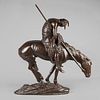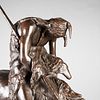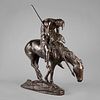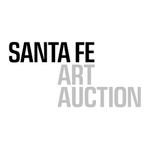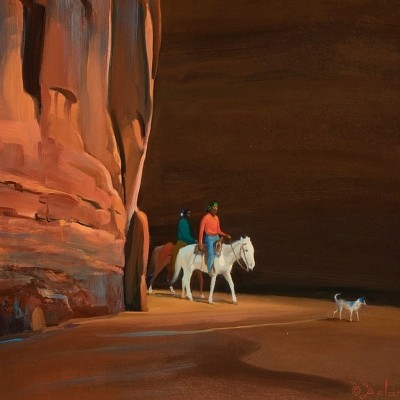James Earle Fraser, End of the Trail, 1915/1967
About Seller
932 Railfan Road
Santa Fe, NM 87505
United States
Boasting the third-largest art market in the United States, Santa Fe has long been a destination for new and seasoned collectors. Located in the heart of the city’s historic downtown, and organized in conjunction with the Gerald Peters Gallery, the Santa Fe Art Auction is the Southwest’s premier ann...Read more
Two ways to bid:
- Leave a max absentee bid and the platform will bid on your behalf up to your maximum bid during the live auction.
- Bid live during the auction and your bids will be submitted real-time to the auctioneer.
Bid Increments
| Price | Bid Increment |
|---|---|
| $0 | $100 |
| $2,000 | $250 |
| $5,000 | $500 |
| $10,000 | $1,000 |
| $20,000 | $2,500 |
| $50,000 | $5,000 |
| $100,000 | $10,000 |
About Auction
Nov 6, 2021
The Santa Fe Art Auction is delighted to present the 29th Signature Live Auction – the pinnacle of our calendar year. This year it brings together the very best of our diverse sale categories, including Native American, Spanish Colonial, Prints and Works on Paper, and fine American art. Santa Fe Art Auction info@santafeartauction.com
- Lot Description
James Earle Fraser
(1876 - 1953)
End of the Trail, modeled 1915, cast 1967
bronze
inscribed near base: J. E. FRASER © SU 21
*The original plasters for these sculptures were bequeathed to Syracuse University by the estate of Laura Gardin Fraser, the widow of James Earle Fraser. Her Estate authorized limited castings to be made from these original plasters.
James Earle Fraser worked as an assistant to Augustus Saint-Gaudens on the Sherman Monument (1892 - 1903), for the Grand Army Plaza in New York. His sculptural entries in major early twentieth century expositions, such as the 1904 Louisiana Purchase Exposition in St. Louis, the 1915 Panama-Pacific Exposition in San Francisco, and the 1939 New York World’s Fair, earned him medals, as well as public and critical acclaim. The design of the Indian head and buffalo nickel for the United States Treasury in 1912, the figure of Theodore Roosevelt on horseback for the entry to the American Museum of Natural History, and numerous other public sculptures, including the Department of the Treasury, the Commerce Building, the National Archives, and the Supreme Court, in Washington D.C., are among the sculptor’s most notable public commissions. The sculptor was also one of the organizers of and contributors to the famous, avant-garde International Exhibition of Modern Art, known as the Armory Show, of 1913.
Fraser’s most acclaimed sculpture neither evokes his European academic training, nor the influence of the East Coast cities where he worked; End of the Trail is a romanticized and nostalgic image of the vanishing West. It is a powerful yet poetic work that is resoundingly clear in its sympathy to the subject matter.
While in Paris he had worked on the theme ( the plaster is now lost) and the work was awarded a gold medal in 1910. By the end of 1913, he had cemented his vision of “an Indian on a horse” and the work was accepted for the Pan Pacific exhibition which opened in February 1915 in San Francisco. End of the Trail was awarded the gold medal as the outstanding sculptural work at the fair. This monumental plaster, which measures eighteen feet high, (National Cowboy Hall of Fame, Oklahoma City) was subsequently cast for sites in public parks, in Wisconsin and California. This image was so popular that the artist issued reductions in various sizes and all were cast at the Roman Bronze works foundry. Fraser at his death bequeathed all of his models and archives to the Syracuse University and they were permitted by the Estate to cast posthumous bronzes from the artist’s original plasters.
34 1/2 x 9 1/2 x 28 in. (87.63 x 24.13 x 71.12 cm.)
Comparative Literature:
Dean Krakel, End of the Trail: The Odyssey of a Statue, University of Oklahoma Press, Norman, Oklahoma, 1973.
Martin H. Bush, James Earle Fraser: American Sculptor, Kennedy Galleries, Inc., New York, 1969.
Alfred T. Colette and Donald M. Lantzy (exhibition catalogue essay), James Earle Fraser: The American Heritage in Sculpture, The Thomas Gilcrease Institute of American History and Art, January 12-April 21, 1985.The bronze is in overall excellent condition.Condition
The condition reports for the lots offered by Santa Fe Art Auction (SFAA) are provided as a courtesy and convenience for potential buyers. The reports are not intended to nor do they substitute for physical examination by a buyer or the buyer's advisors. The condition reports are prepared by SFAA staff members who are not art conservators or restorers, nor do they possess the qualifications needed for comprehensive evaluation. Each condition report is an opinion of the staff member and should not be treated as a statement of fact. The absence of a condition report does not imply anything as to the condition of a particular lot. Buyers are reminded that the limited warranties are set forth in the Terms and Conditions of Sale and do not extend to condition. Each lot is sold as-is. - Shipping Info
-
The Santa Fe Art Auction may, in its discretion and at a Buyer’s request, pack and ship items as directed by the Buyer. In such event, Buyer agrees to the following conditions:
- All such packing, handling and shipping is at the sole risk of the Buyer and the Santa Fe Art Auction shall have no liability for any loss or damage to such items, and
- Buyer shall pay all related expenses in advance. Buyer should allow four to six weeks for shipping from the date of the auction.
SANTA FE ART AUCTION IS PLEASED TO PRESENT THE FOLLOWING SHIPPING OPTIONS. PURCHASES SHALL NOT BE RELEASED UNTIL PAYMENT IS RECEIVED IN FULL.
_____ I would like to pick up my artworks from Santa Fe Art Auction.
Arrangements for pick up must be made within 2 weeks post sale via email or telephone. I understand that I may be liable for New Mexico Sales tax.
_____ I would like my artwork to be released to a third-party shipping company (selected below).
If I select this method of shipping, I understand I must sign and deliver to the Santa Fe Art Auction the Release and Insurance Waiver below.
The UPS Store
3201-C Zafarano Drive
Santa Fe, NM 87505
Telephone: 505-438-2427
store6324@theupsstore.com
PAKMAIL
369 Montezuma Avenue
Santa Fe, NM 87501
Telephone: 505-989-7380
Website: weshipsantafe.com.
Art Handlers LTD
1570 Pacheco St. Suite A-1
Santa Fe, NM 87505
Telephone: 505-982-0228
Other:
Company Name / Authorized Agent _____________________________
Address __________________________
Telephone __________________
E-mail ____________________
RELEASE & INSURANCE WAIVER
- I, ________________ ("Purchaser") have paid for and own the following art: Lot (s) # ________________ (hereinafter "Work(s) of Art").
- I want my Work(s) of Art shipped via this shipper: ___________ ("Shipper"). Santa Fe Art Auction ("SFAA") is hereby directed to release the Work(s) of Art to Shipper at SFAA's location in Santa Fe, New Mexico on a date stated in writing to SFAA by Purchaser.
- SFAA shall be released and discharged from any and all duties of care owing from SFAA to Purchaser and Purchaser hereby unconditionally waives any and all claims against SFAA.
- Purchaser acknowledges and agrees that SFAA, and any of their agents do not carry specific insurance for the Work(s) of Art listed. The Purchaser has agreed to arrange or cause to be arranged the insurance for the transit and handling of the property. SFAA shall bear no responsibility for the adequacy of the Purchaser's insurance.
- Upon delivery of the Work (s) of Art to Shipper, and at all times thereafter, Purchaser shall indemnify and hold SFAA harmless from and against any and all claims related to the Work(s) of Art, directly or indirectly, however such claims may arise.
- Purchaser affirms to SFAA that Purchaser has the authority to execute and perform this Release.
__________________________________________________
Buyers Signature Date
ADDENDUM: Request for Frame Removal
** I, _________________________ ("Purchaser") hereby request the following Lot(s) ______________ be removed from the frame by SFAA prior to release to my selected Shipper.
- Such service shall be provided to the Purchaser at a cost of $_____________ per Lot.
- The Purchaser shall hold harmless SFAA for any and all claim(s), for any loss or damage howsoever occurring, irrespective of negligence, including any claim expense or consequential loss while handling, removing from frame or uninstalling.
-
- Buyer's Premium



 EUR
EUR CAD
CAD AUD
AUD GBP
GBP MXN
MXN HKD
HKD CNY
CNY MYR
MYR SEK
SEK SGD
SGD CHF
CHF THB
THB
